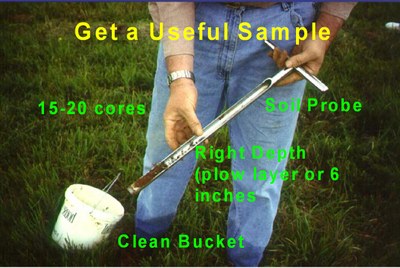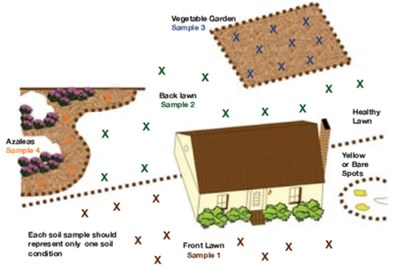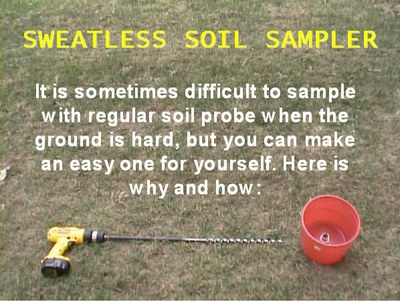Soil Sampling & Tools
Submitting a Sample
Where to Submit Samples for Analysis
The OSU Soil, Water & Forage Analytical Laboratory (SWFAL) works in conjunction with the Oklahoma Cooperation Extension Service. To help serve the state of Oklahoma with testing Services, each County Extension Office is set up to take samples for analysis. Find your local local County Extension Office. The county office will do the initial handling and forward your samples to SWFAL for you.
Step 1. Follow the right procedures to collect representative samples:
- Soil Sample: PSS-2207 How to get a Good Soil Sample
- Water Sample
- Obtain a clean 4 oz water bottle from the County Extension office or a clean drinking water bottle; *Go to the water source that you want to test;
- Fill the water bottle halfway, shake and rinse the bottle and pout out. *Repeat step c. three more times;
- Finally fill the bottle as full as possible getting all air out of the bottle. Cap and submit to your county extension office.
- Forage Sample: PSS-2589 Collecting Forage Samples for Analysis
- Animal Waste and Compost Sample: PSS-2248 Sampling Animal Manure
- Plant Tissue Samples - These samples can be in forage bags or brown paper bags. No
plastic bags. See instructions below for different types:
- Different Crops
- Pecan and Tree Fruits
- Grape Petioles
Step 2. Use a proper and clean sample bag/container to take your sample to your local County Extension Office
- Plastic bags or other clean containers can be used to bring soil samples to extension office. The extension office will transfer samples to our lab soil sample bags. The Lab will not accept a bag less than half full;
- Water should be put in a clean water bottle, and the extension office will pour the sample to our 4 oz plastic water bottles;
- Forage/Solid Feed/Plant Tissue should be put in the Forage Bags. Liquid feed (can only run Protein) should be put in the 4 oz plastic bottle;
- Animal waste Solid/Compost must be put in two plastic zip bags. Liquid should be put in the 8 oz plastic container and only filled half; then the plastic container should be put in a zip bag. Liquid animal waste has a tendency to expand and can explode in transit. The plastic zip bag can help keep everything contained and not lost in transit.
Step 3. Tell the county extension office what tests you want to do, and the office will clearly mark the tests on the sample containers. If you are not sure what test is needed, your local County Extension can assist with questions. They are there to help!
Step 4. Payment is expected at time of sample drop off. See a list of Services and Price List.
Helpful Hints on Taking/Submitting Samples
- The more information put on the tags, the easier the identification in cases where samples are not claimed or labels fall off.
- Please write in a crop (list found below) on the tag for Fertility and Forage samples. This not only allows interpretations to be printed on the reports, but also helps with research and statistics done by the lab each year.
- Tie all sample bags with a Granny Knot or Double Overhand Knot to ensure no spilling while in transit. There should not be a gap when closing the bag. If so, take a little soil out.
- Please use pencil or ball point pen to mark the sample tag. Moist soil will cause some inks to run and make it difficult to read the tags after the sample reaches the lab.
- Always double zip lock bag animal waste samples – Solid, Slurry or Liquid.
- Comprehensive Salinity needs a full bag of soil for the complete test. If other analyses are needed, submit another bag of soil.
- If the soil is pretty sandy and Comprehensive Salinity is required – send two bags of soil. Tie both bags of soil together and mark 1 of 2 and 2 of 2 on the bags.
- Soil Samples with less than half of a bag should not be sent. A full bag is acceptable. By filling the bag, this will ensure enough soil to be tested and if more tests are to be added, we can certainly do so.
- Never put Plastic bags inside sample bags – Soil or Forage. It is perfectly fine to put the sample bags in the zip lock. (Samples go into the oven)
- Do not send Rocks in samples. This will harm the equipment.
- Do not send oil Saturated Samples. We can not run them.
- Do not send Glass Containers.
- Do not fill an Animal Waste Liquid Container more than half full. Animal Waste has a tendency to expand and can potentially explode.
- Do not tape water bottles, just tighten lid properly.
- SWFAL does not test for Bacteria and trace metals. Please refer to the listing of Independent Laboratories for these analyses.
- If accurate moisture results are needed, place the forage bag in a zip-lock bag and seal.
Crop Code Choices
| Crop Code # | Crop | Possible Yield Goals | Units | Estab | NRCS Estab |
|---|---|---|---|---|---|
| 1 | Wheat | 15 - 100 | bu/acre | ||
| 2 | Barley | 15 - 100 | bu/acre | ||
| 3 | Oats | 15 - 100 | bu/acre | ||
| 4 | Grain Sorghum (milo) | 30 - 230 | cwt/acre | ||
| 5 | Corn | 40 - 200 | bu/acre | ||
| 5 | Sunflower | 40 - 200 | bu/acre | ||
| 6 | Cotton | 0.5 - 3.5 | bales/acre | ||
| 7 | Corn Ensilage | 5 - 30 | tons/acre | ||
| 8 | Sorghum Ensilage | 5 - 30 | tons/acre | ||
| 9 | Fescue | 1 - 5 | tons/acre | Y | Y |
| 9 | Any Cool Season Grass | 1 - 5 | tons/acre | Y | Y |
| 10 | Orchardgrass | 1 - 5 | tons/acre | Y | Y |
| 11 | Rye Grass | 1 - 5 | tons/acre | Y | Y |
| 12 | Weeping Love Grass | 1 - 5 | tons/acre | Y | Y |
| 13 | Bermuda grass | 1 - 7 | tons/acre | Y | Y |
| 13 | Any Warm Season Grass | 1 - 7 | tons/acre | Y | Y |
| 14 | Peanuts | No yield goal required | |||
| 15 | Soybeans | No yield goal required | |||
| 16 | Mungbeans | No yield goal required | |||
| 17 | Cow Peas | No yield goal required | |||
| 18 | Guar | No yield goal required | |||
| 19 | Small Grains for Grazing | 0.5 - 3 | tons/acre | ||
| 20 | Legumes in Pasture | No yield goal required | |||
| 21 | Alfalfa | No yield goal required | |||
| 22 | Sorghum Sudan Hay | 1-15 | tons/acre | ||
| 22 | Haygrazer | 1-15 | tons/acre | ||
| 23 | Garden | No yield goal required | |||
| 23 | Flowers or any vegetable specific | No yield goal required | |||
| 24 | Lawn | No yield goal required | |||
| 25 | Native Hay | 1.0 or 1.5 | tons/acre | ||
| 25 | Native Grass | 1.0 or 1.5 | tons/acre | ||
| 26 | Hairy Vetch | No yield goal required | |||
| 27 | Other Clover | No yield goal required | |||
| 28 | Millett | No yield goal required | |||
| 29 | Wheat Silage | No yield goal required | |||
| 30 | Feed Mix | No yield goal required | |||
| 31 | Peanut Hay | No yield goal required | |||
| 32 | Trees | No recommendations given by lab | |||
| 33 | Roses | No recommendations given by lab | |||
| 34 | Bluestem | 1-5 | tons/acre | Y | Y |
| 35 | Arrowleaf Clover | No yield goal required | |||
| 36 | Jose Tall Wheatgrass | 1-5 | tons/acre | Y | Y |
| 37 | Canola | cwt/acre | |||
| 38 | Grape | No yield goal required | |||
| 39 | Johnson Grass | No recommendations given by lab | |||
| 40 | Wildlife Plot | No yield goal required | |||
| 41 | Peach Tree | No yield goal required | |||
| 42 | Pecan Tree | No yield goal required | |||
| 43 | Other Orchard | No yield goal required |
Notes
- If Crop is marked Bermuda grass for Lawn, Lawn Inter will be used.
- If no crop is provided and CRP is written on the tag, Login will use Bermuda and NRCS Estab.
- If crop needed is not listed, please use crop above with similar properties.
- NRCS Estab (COST SHARE) will override Establishment when both are marked.
- Yield goals listed above give the possible range for recommendations given on reports.
| Crop Conversion | Conversion | Units |
|---|---|---|
| Cotton | 480 | lb/acre |
| Wheat | 60 | lb/bu |
| Barley | 48 | lb/bu |
| Corn | 56 | lb/bu |
| Oats | 32 | lb/bu |
| Sorghum (Milo) | 56 | lb/bu |
Frequently Asked Questions
- What is a Soil Test?
A soil test is a process by which nutrients are chemically removed from the soil and measured for their plant available content within the sample. The quantity of available nutrients in the sample determines the amount of fertilizers needed for a particular crop. A soil test also measures pH and the amount of acidity within the soil to determine if lime is needed and how much should be applied.
- How often should a soil be tested?
A soil test should be conducted if fertilizer is going to be applied or when problems occur during the growing season. Once every year is recommended when nitrogen fertilizer is applied, and at least once every three years if P and K are concerned.
- When is the best time to take soil samples?
Soil samples can be taken any time throughout the year for checking pH, phosphorus and potassium status. Collect soil samples 1-2 months before planting. Early spring is a good time to take soil samples for summer crops, and summer is a good time to sample for fall and winter crops. This allows time for lime recommended to react with the soil and change the pH before the crop is planted. To assess soil available nitrogen, sample as close to planting as possible. For Lawns, the late spring (May) is a good time sample for warm season grass and the summer (mid-Aug) is good for cool-season grasses.
- What tools and supplies are needed to take a soil sample?
A clean plastic bucket, a soil probe or a shovel are needed. Soil probes may be borrowed from your local County Extension Service office.
- How should a soil sample be taken?
Collect a core with a probe, or a slice with a shovel, of soil from the surface to 6 inches deep from 15-20 random locations across the sampling area. Mix the samples together in a clean plastic bucket. Put 2 cups of the mix into a soil sample bag or a clean container and label it, e.g., FRONT, BACK, SIDE of the house. For most garden areas one sample/plot should be adequate. When you return the sample to the Extension Office specify the crop you wish to grow and the yield goal (lawn, garden and legume crops do not need yield goal).

For more information please check PSS-2207 How to Collect a Good Soil Sample.

A soil sample should not represent more than 40 acres for field crops. Several separated samples may be needed from a yard to reflect the different uses.
- Can samples be taken when soils are wet?
Soil moisture does not affect the test results since samples are dried before they are analyzed. However, extremely wet soils are difficult to collect and mix. Therefore, allow soils to drain before sampling. Soils too dry are normally hard to get to the right depth.
- Where can I buy soil sampling probes?
The following companies sale soil sampling tools: (this list is not all inclusive)
- How to set a realistic yield goal?
Aim for above average yields so crop yields will slowly increase over time. Keep a good production record of each field on the farm for at least five years. Some fields may produce more than others because of differences in soil quality and other factors. Adjust the past average to set a yield goal. The practical range for a yield goal should be somewhere above average to near the maximum yield in the last 3 to 5 years. Two common methods for calculating realistic yield goals are:
- to add 10 to 30% to the recent average yield;
- to take the average of the 3 highest yields in the last 5 consecutive years. Regardless of the method you employ it is important to be consistent from one year to the next.
- How to handle animal manure samples?
Manure samples can come in different forms: solid, liquid, or slurry. They need to be handled properly to ensure safe shipment to the laboratory.
Solid samples: Place about 1 pound of representative solid sample, such as poultry litter and feedlot manure, in a quart sized plastic bag. Do not use soil or forage bags for manure samples because some nutrients may be lost before testing. Put completed sample label on the bag and place it in a second plastic bag the same size or larger for extra safety.
Liquid or slurry samples: Liquid and slurry samples should be placed in a quart sized plastic bottle with a screw top lid (it can be ordered from the lab). Do not use glass bottle since it may break. Bottle should be filled at least half way with representative sample. Screw lid on tightly. Put sample label on the bottle and place the container in a zip-lock plastic bag.
Use cardboard boxes to ship sample bottles and bags. Pack the box tightly with expanded Styrofoam peanuts or shredded paper and seal with strapping tape. Ship samples to the laboratory as soon as possible.
Preservatives are generally not needed for manure samples used for fertilizer recommendations.
- Where can I buy forage sampling tools?
A portable hay probe can be purchased from SWFAL.
Forage Probe
When the probe is not in use is measures about 24" long and 2.5" thick.
This is assembled for use.
More selections for forage sampling tools can be found on the National Forage Testing Association Website.
- Information about the Sweatless Soil Sampler

Advantages
- Easy to get into the soil
- Easy to control depth
- Samples are collected into the bucket for you
- Easy to make
- Use what you already have
- Easily modified
Parts Needed
- Long Ship Auger 3/4" dia, 17-18" length
- 12-18" Extension
- 1 1/2" 3/4" PVC schedule 40 pipe
- 3/4" Threaded PVC coupler
- Conduit nut
- Cordless drill (12 to 18 volts recommended)
Costs
- Ship Auger - $26
- Extension - $6
- Bucket - $2
- PVC Pieces - $1
- Total $35
- Ability to make your own modifications - Priceless
- Standard Soil Probe - $50 and up


